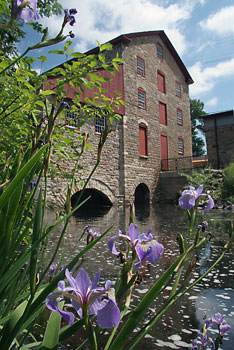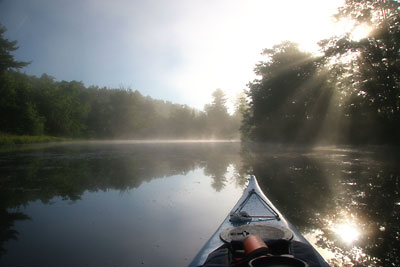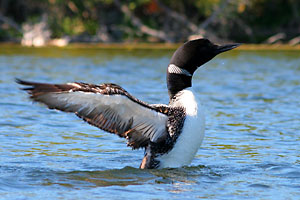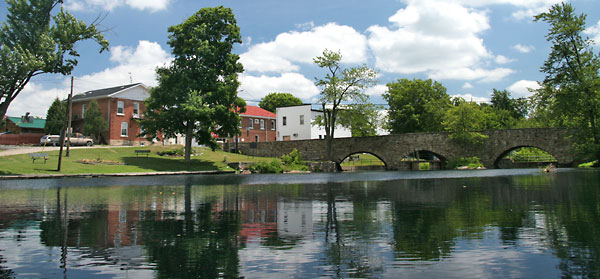 |
Sunrise on Upper Beverley Lake
The Beverley lakes; Upper Beverley and Lower Beverley, provide great opportunities for interesting paddling day trips. The ideal starting point is Delta, which provides easy access to both lakes as well as camping facilities. All the information on this page is included in a PDF version of the guide:
Water Access
 |
| Old Stone Mill |
Upper Beverley Lake: Access is from a public boat launch, located on UB5 road, at co-ordinates 44° 36.780'N. 76° 06.985'W. The road is poorly marked (a small blue marker), but it is the only road to the east, north of the Delta Mill, between the mill and Daytown Road (the next road to the east). There is lots of parking available and it's an easy launch to use.
Lower Beverley Lake: Access to the lake is available in Delta from the public boat ramp located adjacent to Lower Beverley Lake Park (a campground) at co-ordinates 44° 36.575'N. 76° 07.420'W. Take Lower Beverley Lake Park Road and look for the Boat Launch sign. It features a paved ramp and dock with lots of parking.
Lyndhurst Creek: Access to the creek in order to paddle to Lower Beverley Lake is available from a public boat launch in Lyndhurst at co-ordinates 44° 33.040'N. 76° 07.550'W. Turn north onto Water Street, which is adjacent to the east side of the stone bridge. You'll find a small public park, a dock and the boat launch.
Morton Creek: Access to the creek in order to paddle to Lower Beverley Lake is available from a small parking/picnic area, located adjacent to the creek, on the west side of Highway 15 at co-ordinates 44° 32.375'N. 76° 11.880'W.
Facilities
Lodging: Lower Beverley Lake Park in Delta is a full service campground ("106 acres of vacation fun"). You can get full details about the park at: www.beverleylakepark.com.
Supplies: A local source for supplies is Elgin, which has a grocery store, pharmacy and hardware store. Lyndhurst has a small grocery store and a hardware store.
Rentals: Those staying at Lower Beverley Lake Park may rent canoes or kayaks from the park. Canoe and kayak rentals are also available in Gananoque and Kingston.
Etiquette
Your trip planning should include a "leave no trace" approach - carry out what you carry in. Many areas are un-serviced (no garbage cans) - so plan to be self-contained. If you are staying in a spot such as Lower Beverley Lake Park, then you'll have access to waste disposal facilities.
The Lakes
Upper Beverley Lake
This lake served as the mill pond for the Old Stone Mill. Originally two smaller lakes, the Old Stone Mill and its bywash dam, built in 1810, raised the level of water in the lakes to create one lake. Today, the government dam in Delta, built in 1962, maintains Upper Beverley as a single lake, the level about 3 metres (10 feet) higher than the original water levels. The maximum depth of the lake is 7 metres (23 feet) with an average depth of 2.5 m (8 feet). This shallow, warm water lake is home to many fish species including largemouth bass, smallmouth bass and northern pike. You’ll also find many species of birds such as ducks, herons, ospreys, and loons as well as typical near shore wildlife such as frogs, turtles, muskrats and beavers.
The direct paddling distance from Delta to the head of the lake (at Plum Hollow Creek) is 6.5 km (4 miles). The circumference of the lake (along main shorelines) is about 22 km (14 miles).
While there is some cottage development (three areas of high density cottages), most of the shoreline remain in its natural state.
Lower Beverley Lake
Slightly larger than Upper Beverley Lake, this is a much deeper lake with a maximum depth of 28.7 m (94 feet) and an average depth of 9.1 m (30 feet). The lake hosts many species of fish, and, like Upper Beverley, the dominant species are largemouth bass, smallmouth bass and northern pike. The lake region hosts a variety of wildlife (see the listing for Upper Beverley Lake). The level of the lake is dam raised (at Lyndhurst) by about 1.8 metres (5 feet).
The circumference of the lake, along main shorelines is about 28 km (17 miles). One can also paddle through the lake to either Lyndhurst or Morton (see below).
There is a fair bit of cottage development, mostly along the eastern and southern shorelines. However, many areas of natural shoreline remain.
Lyndhurst Creek
This is the outlet of Lower Beverley Lake. It's a slow moving, deep water creek, generally with marshy shorelines. It is about 4.3 km (2.7 miles) from Lower Beverley Lake to Lyndhurst.
Morton Creek
Flowing from the Rideau Canal dam at the foot of Morton Bay to Lower Beverley Lake, this is a slow moving meandering creek, bordered by farmland and some marshy areas. It is about 5.4 km (3.4 miles) from Morton to Lower Beverley Lake.
 |
| Misty Morning on Morton Creek |
Points of Interest
Delta: first settled by Abel Stevens in 1796, the main feature is the Old Stone Mill, built in 1810 and open to the public today (see www.deltamill.org for details). A beautiful three and a half storey stone building, you’ll find many interpretive displays inside as well as a working water wheel, mill stones and a bolter. Adjacent to the mill is the Delta Mill Society’s Blacksmith Shop, recently (2022) renovated to provide for a better public experience. During the summer season, public washrooms can be found in the Old Town Hall (on the road leading to Lower Beverley Lake Parks). All three buildings are owned and operated by the non-profit group, The Delta Mill Society.
Lyndhurst: The most striking features in Lyndhurst is the old three-span stone bridge, built in 1856-57 and reputedly the oldest bridge still in use in Ontario. Lyndhurst was originally called Furnace Falls since it was the site of the first iron ore smelter in Ontario ( 1801-1811). The “Great Falls” at Lyndhurst provided water power for the furnace and mills. The remains of the old Roddick mill can still be seen below the bridge. You can paddle all the way to Gananoque by putting your boat in at the public dock on Lyndhurst Lake. The dock is located at the foot of Ford Street, about a 650 metre (710 yard) portage from the boat launch on Water Street.
Morton: an old road (550 metres (600 yards) long) links the canoe/kayak launch on Morton Creek with Morton Bay on the Rideau Canal. About halfway up the road you’ll see the foundation remains of George Morton’s mills in the valley below the road. At the head of the road you’ll find a parking lot and the Morton Dam (a Rideau Canal dam operated by Parks Canada). If you cross the dam and walk up the trail on the other side, you’ll discover a terrific view at the top, the former location of a wooden guardhouse built in 1838 (now long gone) to defend the dam. This area was first settled by Lemuel Haskins in about 1803. Lemuel and his brother Carey built a sawmill and mill dam at the location of Whitefish Falls (where the current dam is today). You can paddle the Rideau Canal by putting your boat in at the public dock (Parks Canada) in Morton Bay, just below the parking lot beside the canal dam.
 |
Loon Stretching on Lower Beverley Lake
|
Upper Beverley Lake: mostly nature interest, particularly in the marshy areas near the middle and the head of the lake. Paddle part way up Plum Hollow Creek and get a sense of the exploration by Lt. Joshua Jebb, who paddled this way in 1816, preferring a canal route through here (known as the Irish Creek Route) to that by way of the Rideau Lakes (the route of the Rideau Canal today (see the Human History section). The first settlement of this region in February 1794 was on the good farmland located on the upper reaches of Plum Hollow Creek.
Lower Beverley Lake: a feature of the lake are the 14 islands, often distinctive in both physical character and cottage development. Cottaging on Lower Beverley goes back to the late 1800s and a lake association (Lower Beverley Lake Association) is very active on the lake. You can paddle along the developed shorelines (mostly eastern and southern), admiring the various styles of cottage architecture, and/or look at the less developed western shoreline, particularly the areas of Oak and Lost bays. Paddling the full circumference of the lake makes an interesting day trip. A must-see is the Canoeshuk which you'll find just south of English Island at: 44° 35.530'N - 76° 08.225'W
Geographic History
The Beverley Lakes are located at the edge of the Frontenac Axis, part of the Canadian Shield, rocks of Pre-Cambrian (very old) age. Lower Beverley Lake is completely surrounded by Pre-Cambrian rocks, mostly crystalline limestone (marble). Upper Beverley Lake is partially on crystalline limestone and much younger (Lower Ordovician) sandstone.
The lakes looked a bit different in the pre-mill dam era (pre-1790s). At that time, both lakes were lower, Upper Beverley by about 3 metres (10 feet) and Lower Beverley by about 1.8 metres (5 feet). In fact Upper Beverley was two smaller lakes. Lower Beverley Lake was part of a much larger Gananoque watershed than exists today. All the waters from several of the lakes that are today part of the Rideau Canal (Newboro, Clear, Indian, Opinicon and Sand), flowed through the Jones Falls Rapids, the head of the White Fish River. That river flowed into Lower Beverley Lake, then known as White Fish Lake, and those waters continued, as they do today, through Lyndhurst and down to Gananoque.
It is due to this original watershed configuration that it was the main indigenous paddling route for the region. At that time, there was no direct water connection to Kingston, the present day connection of the Rideau Canal, from Whitefish Lake to Upper Brewers was a non-navigable (above water in summer) area of forest and marsh. It stayed this way until the first mill dams in the areas (at Morton in about 1803 - see below) flooded the forest and marsh to make a navigable connection to the Cataraqui River.
Human History
As you paddle the Beverley lakes, you’ll be padding through areas that have experienced some very interesting history. Paddling on these lakes goes back thousands of years. Lower Beverley Lake was on the main indigenous paddling route connecting the St. Lawrence River with the Ottawa River. Indigenous artefacts, dating back 1,000s of years, have been found here. Originally used by paleo-peoples, when indigenous nations started to form, it became a travel route used by the Iroquois, Mississauga and Algonquin peoples. Today, Upper and Lower Beverley Lakes are on the southern boundary of the Algonquin Land Claim (agreement in principle in 2016).
The first mapping of the route was in 1783, when Lt. Gershom French paddled from Rideau Falls (on the Ottawa River) to Gananoque (then simply the outlet of the Gananoque River). French's map and survey description don't provide any detail about Lower Beverley Lake, but even though it was about 2 m lower at the time, it would have looked much like it does today.
Settlement started when elder Abel Stevens led a group of settlers up from Vermont to settle in what is today's village of Delta. A set of rapids on Delta Creek made it a potential mill site and Stevens petitioned to be granted land for settlement and for the water rights. This forced the government to conduct a survey, in order to lay out a township, so that lots could be granted.
Provincial surveyor Lewis Grant did an initial exploratory survey in 1795, tying into survey lines done the year before by William Fortune. Grant returned the next year and did a full township survey (Bastard Township). This allowed the government to award Abel Stevens land grants in June 1796 which included 3 lots that form today’s Delta.
Provincial surveyor Lewis Grant did an initial exploratory survey in 1795, tying into survey lines done the year before by William Fortune. Grant returned the next year and did a full township survey (Bastard Township). This allowed the government to award Abel Stevens land grants in June 1796 which included 3 lots that form today’s Delta.
After arriving in the area, Stevens also turned his focus on obtaining the water and mineral (iron) rights for an iron ore deposit near the great falls in Lyndhurst. However, there were competing interests and it was not until 1801 that a furnace and a foundry, the Lansdowne Iron Works, were erected by Wallis Sunderlin, a Vermont Founderer. This location (today’s Lyndhurst) became known as Furnace Falls. It was likely that a dam was erected at Lyndhurst at that time, raising the level of Lower Beverley Lake. The furnace and foundry operated with limited success until it burned down in 1811. It was never rebuilt.
Back in Delta, at least two grist mills were constructed in the early 1800s. The original sawmill was rebuilt at least once (it had burned down). But the biggest change was to come when William Jones bought Abel Stevens’ mills and area property in 1808. Jones and his partner, Ira Schofield, decided to build a new grist mill. This was not to be any grist mill, but a magnificent three and half storey stone structure incorporating the latest in automatic milling technology. Due to the necessity of placing this very heavy stone building on a bedrock foundation, it was built about 30 metres (100 feet) away from where the original Stevens’ mills were located. Construction started in 1810 on the west side of the creek. A new channel from Upper Beverley Lake was constructed, using pry bars and black powder blasting, to the location of the new mill. When the mill was completed, the original course of the creek was filled in and the water flow diverted into the new channel leading to the mill. This is the configuration that exists today, the water from Upper Beverley Lake flowing along the artificial channel that leads to the mill. A major change was done in 1962 with a new dam was built by the government upstream of the bridge. The original dam was a stop-log dam at the head of the mill’s bywash (water by-pass channel) located adjacent to the west side of the mill.
The water in Upper Beverley Lake has been raised by about 3 metres (9 to 10 feet), originally in 1810-11 by the Old Stone Mill and its stop-log dam, and now by MNR’s stop-log dam located just upstream of the bridge. Today, due to this dam, the water in front of the mill is about 1.8 metres (5 feet) lower than it was prior to 1962.
In about 1803, Lemuel Haskins arrived at the location of Morton, then the White Fish Falls, and, together with his brother Carey, decided to use that water power for a sawmill. They dammed the creek above the falls, backing up the water into Morton Bay and flooding the Cranberry Flood Plain (located between the White Fish River and the Cataraqui River which had its headwaters in Dog and Loughborough lakes). The Haskins brothers found that his dam raised water was escaping through the forests and marsh that made up the flood plain, and to stop this escape erected a second dam at the Round Tail, a rocky constriction just above Upper Brewers. This second dam raised about 6 feet of water over the flood plain, making it navigable by canoe (the area now occupied by Whitefish Lake, Little Cranberry Lake and Cranberry Lake).
Haskins’ dam is significant, since it took half the original western watershed of the Gananoque River (water that flows into Lower Beverley Lake) and diverted most of it south to the Cataraqui River.
Haskins’ dam is significant, since it took half the original western watershed of the Gananoque River (water that flows into Lower Beverley Lake) and diverted most of it south to the Cataraqui River.
Jebb proposed to continue the canal up Morton Creek and re-join the original Rideau route at Morton Bay. A minor hiccup in Jebb’s plans was the lack of water at the top of the Irish Creek watershed. Jebb suggested that a 5 mile (8 km) rail road could be built, linking Irish Creek with Upper Beverley Lake and that goods could be offloaded from one batteau, railed across the watershed divide and then loaded onto a batteau on the other side.
In 1823/24, Jebb's proposed canal route through the Beverley lakes was discounted by surveyor Samuel Clowes who was looking for a fully navigable (water all the way) route. He noted that to supply water to the top of the Irish Creek/Plum Hollow Creek divide, a 10 mile (16 km) feeder canal would have to be run from Rideau Lake. The cost of doing that was much more than simply taking the route through the Rideau lakes. So, the Beverley lakes remained uncanalized.
By 1832, Haskins' mill dam at White Fish Falls had been replaced with a Rideau Canal dam, locking in the geography we see in that area today.
Milling thrived, with the Old Stone Mill in Delta remaining the single largest mill in the region. As agriculture spread, the need for mills increased. In 1827, Charles and Jonas Jones built a grist mill and a sawmill at Lyndhurst. In the 1850s, George Morton expanded the milling facilities in Morton. In 1869, John Roddick added a large stone grist mill at Lyndhurst.
The 20th century brought hard times to the mills, grain could now be easily transported to larger industrial facilities. Local mills struggled to be economic. Some, such as the Roddick mill in Lyndhurst and Morton’s mills in Morton were simply abandoned and allowed to crumbled away. The Old Stone Mill in Delta produced flour up until about 1940, animal feed up until about 1950 and then became solely a store selling commercially produced flour and feed. In the 1960s, the last owner, Hastings Steele, sold the mill for $1 to a group of four people who then formed The Delta Mill Society. That society has worked hard over the last few decades, including investing well over 2 million dollars in restoration work, to restore the mill to its former 1810 glory.
Sources of Information
There are a host of resources available on the Internet to help with your visit to this region. These include:
Paddling the Frontenac Arch: www.explorethearch.ca/paddle-the-arch
Paddling the Rideau Canal: www.rideau-info.com/canal/paddling
Old Stone Mill: www.deltamill.org
Lower Beverley Lake Park: www.beverleylakepark.com
Lower Beverley Lake Association: lbla.net
About This Guide
This guide has been prepared by Ken W. Watson on behalf of The Delta Mill Society. Ken has kayaked both lakes as well as Morton and Lyndhurst creeks. Ken also runs a large non-commercial website about the Rideau Canal at www.rideau-info.com.
 |
| Lyndhurst |
|
 |
|
The Delta Mill Society
Box 172, Delta, Ontario K0E 1G0
Tel: 613-928-2584 (office)
Email: info@deltamill.org |
 |
|
 |

